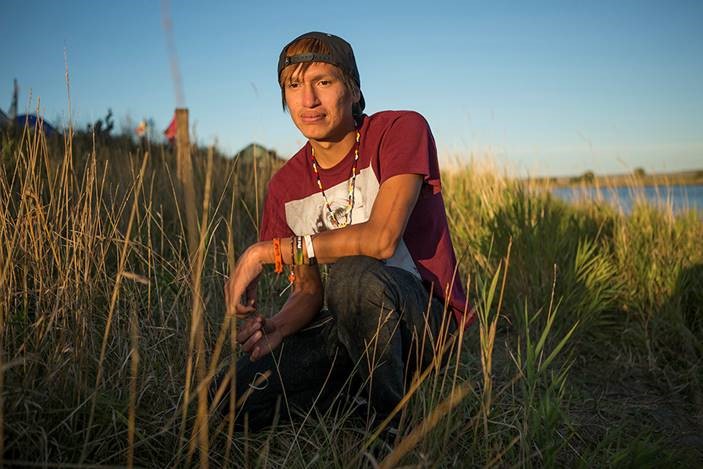
On April 1, 2016, Native Americans from across the country gathered at Sacred Stone Camp in Cannonball, ND, to protect the Missouri River.
They ran to draw attention to their opposition of the Dakota Access Pipeline (DAPL), a proposed crude oil pipeline that would stretch 1,172 miles from North Dakota to Illinois. Activists worry that a spill could be catastrophic for communities along the pipeline, as it runs underneath the Missouri River, which provides drinking water to ten states and 28 tribes. Spearheading the massive campaign against the DAPL are the Standing Rock Sioux, whose reservation lies half a mile from the pipeline route, and who are gravely concerned about the DAPL crossing ancestral burial sites on their traditional territory.
Danny Grassrope, a 25-year-old Kul Wicasa Lakota, was not among the activists then. He didn’t know what DAPL was or that people were protesting it. He was living in McLaughlin, SD, a small town on the South Dakota side of the Standing Rock Reservation. Mostly, he was getting drunk every night.
“I grew up in an alcohol environment,” he says. “I didn’t know it was unhealthy for me. I didn’t know it was going to affect me in the way it did.”
His alcohol consumption grew so bad that Grassrope was kicked out of class one day for arriving drunk, and he ended up dropping out of college.
“I guess that’s where I started to get lost. I didn’t know what to do with my life. I didn’t want to be nothing.”
A former high school and college runner, Grassrope still ran to keep in shape. And he’d pray when he ran: “I was asking, ‘God, just let something come my way so I can feel a part of life.’”
In April 2016, weeks after the start of the Standing Rock encampment, Grassrope saw a flier on Facebook for a run—564 miles from Cannonball, NC, to Omaha, NE, over eight days—to raise awareness of the fight against the DAPL. An old friend of his, Bobbi Jean Three Legs, was organizing it with a group of Native youth called ReZpect Our Water (ReZpectOurWater.com). He decided he wanted to take part.
“They were running through [my hometown] Lower Brule, so I texted Bobbi Jean and said ‘I’m going to run with you,’” says Grassrope.

Danny Grassrope at Standing Rock, photo by Sarah Stacke. Above: The young runners of ReZpect Our Water, courtesy of ReZpect Our Water.
That run changed his life. The group covered 40 to 80 miles in relay each day, while bearing signs and shirts to promote safe water and advocate against the pipeline. As they ran through reservations and towns, runners stopped to make speeches about the importance of stopping the pipeline and invited locals to run with them.
Grassrope ran 10 to 15 miles per day with the group, which grew and shrank each day as they were joined by school children, community members, and tribal elders. Eleven runners made it from start to finish.
“I have been running with them since,” says Grassrope. “I started to know the cultural side of who I am, and the spirituality we have as a people. It was just mind-blowing, that I was meant to be something. I was meant to be here.”
After the run to Omaha, he visited the Sacred Stone camp and then participated in a 22-day relay, organized by ReZpect Our Water and People Over Pipelines, from the camp to Washington, DC, last summer, in which hundreds participated and 40 runners made it all the way to DC. After that, Grassrope moved to Sacred Stone Camp for seven months, and he wasn’t alone. Activists started pouring into the camp after the DC run, when in the previous months it had been a much smaller movement.
Grassrope remained at Standing Rock until the water protectors were evicted at the end of February 2017. While there, he helped form the International Indigenous Youth Council, which advocates for Native youth to be fully educated and integrated into the struggles of Native people, which he says adults often try to shield them from.
“When I grew up, I didn’t know that we were conquered people. I knew there was war, but I didn’t get the message of what our people went through,” he says. “I know the teachings of historical trauma and why [alcoholism is a problem for Native communities] now, but I didn’t then.”
Since last summer, ReZpect Our Water has been working to amplify Native voices through social media and by organizing people in their hometowns for clean water. The group is also planning new prayer and healing runs.
Grassrope says the runs can be used anywhere Native people are being threatened by development, to raise awareness and build community: “Hopefully, it ripples, the movement keeps going, and other people in other towns start running like this.”







